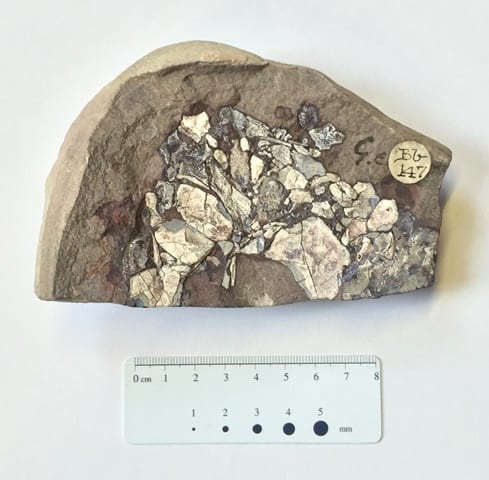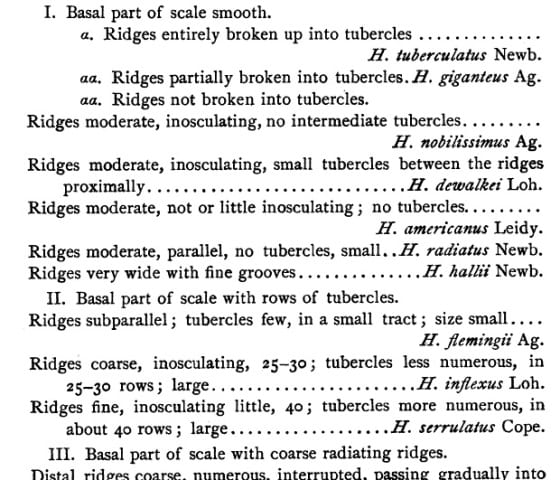Underwhelming Fossil Fish of the Month September 2016
By Mark Carnall, on 29 September 2016
The ides of October are almost upon us which means many things. One of the least noteworthy things it means, however, is that it’s time for another underwhelming fossil fish of the month. In this confusingly titled series, we look at an underwhelming fossil fish from the Grant Museum of Zoology collection every month. Unlike the plastic dinosaur casts and errr more plastic dinosaurs casts, these poor fossil fish, which fill the drawers of museum collections, rarely make it into displays and exhibitions. If they do, like this recently spotted specimen on display at Scarborough’s Rotunda Museum, there’s not much to say about them beyond ‘Fish’. Or is there?
No. No there isn’t really. BUT HERE WE GO ANYWAY.
Here’s this month’s underwhelming fossil fish specially chosen for this blog found in the first drawer that was searched. Don’t be confused, it does look like February 2014’s underwhelming fossil fish, Glyptolepis leptopterus, but the similarity is due to the method of preservation which palaeontologists technically call ‘resembling a packet of M&Ms that has been spilled on the floor, melted and faded by the Sun and then trampled on’.

LDUCZ-V1723 Holoptychius sp. SCALE BAR FANS this month’s scale bar also helpfully illustrates what circles look like at different distances.
Catalogue information about this specimen is SCANT. This specimen is identified as Holoptychius sp. and was collected from Ethie Bay in Scotland. Honestly, I’m going to blindly accept the label identification because, well, look at it. It’s one of the most underwhelming fossil fish featured here for a while. Somebody actively decided to collect this specimen for a museum collection, imagine what was left at the field site.
Holoptychius is a genus of sarcopterygian fish, a group whose living relatives includes fish such as lungfish, coelacanths and technically, you, me and the dog. Sarcopterygian fish are the group thought to be ancestral to all tetrapods.
Holoptychius is known from Devonian deposits, across the globe, making this bad boy between 350 and 400 million years old, give or take 10 million years.
Preservation This poor specimen has been preserved in a state of discombobulation, with what looks like scales and bones compressed, mixed up and broken which is fairly typical for these fossils, making identification difficult. If you stare at the image long enough, you might be convinced that you can discern what may be a jaw. the larger elements could be from the face. Picasso’s seated woman can also be seen here:
Writing about this group in 1897, LEGENDARY PALAEONTOlOGIST Edward Drinker Cope mentions that Holoptychius can be easily identified depending on whether the basal part of the scale ridges are moderate and inosculating as well as the presence, size and orientation of tubercles (Cope 1897). Looking at this fossil, I can definitely, clearly and easily identify these features so I have identified this specimen to species but in the interests of science, I’m going to let you have a look and identify it for yourself. It is very easy and I definitely do know which species it is though.

Using this guide from Cope 1897, it is very easy to identify this specimen to species level. I did it with no problems at all from these well described characteristics. But I’ll let you work it out.
Research Aside from Cope’s identification guide, which makes identifying this specimen to species really easy, even for people who write about fossil fish who might be struggling, it’s a widely cited species, recorded as present in fossil assemblages but not much more detail is given in many publications. For example, in the accessibly titled paper Memoir to Accompany a Map of the Magnetic Variation for 1840 in the Atlantic Ocean between the Parallels of 60 degrees N. and 60 degrees S. Latitude, Being Contributions to Terrestrial Magnetism, No. 9. the osseus tissues of Holoptychius are described as “exceedingly beautiful and complicated” (Sabine 1834). Thanks Sabine.
Unlike almost every single other underwhelming fossil fish, Holoptychius, is at the very least mentioned in some sexy, top shelf titled, palaeontological publications (I sadly can’t access as they are paywalled). Living legend, palaeontologist Jennifer Clack says something about Holoptychius in the excitingly titled volume The First Feet: Tetrapods of the Famenian. That would have been the sexiest paper title pertaining to a fossil fish specimen we’ve seen in this series if it weren’t for Holoptychius getting some kind of mention in George McGhee Junior’s book chapter When the Invasion of Land Failed: The Legacy of the Devonian Extinctions. Which is a B movie just waiting to be made. Rumours are that a screenplay is being written for it right now.
In Society
SCREENPLAY ‘WHEN THE INVASION OF LAND FAILED’
EXT. A DEVONIAN BEACH. CRASHING WAVES ARE THE ONLY SOUND
HOLOPTYCHIUS in their hundreds are lined up at the surf’s edge, bobbing backwards and forwards with the tide. Focus in on the face of the largest HOLOPTYCHIUS near the front of the ranks, it makes a ‘look’ which could be interpreted as determination. As if on command all of the HOLOPTYCHIUS begin to emerge out of the water onto and onto land.
RIDE OF THE VALKYRIES begins to play.
FADE TO BLACK.
EXT. A DEVONIAN DUNE, SOME WAY FROM THE BEACH
Scores of HOLOPTYCHIUS lay strewn around, many are still, others make occasional spasms and gasping noises.
FADE TO BLACK
THE END
Holoptychius sp.
Preservation 4
Research 5+(?)
In Society Academy Award Winner, Best Animated Short Film. Academy Award Winner, Cinematography. Academy award Winner, Writing (Original Screenplay)
Underwhelmingness 8
References
Cope, E. D. 1897 “On New Paleozoic Vertebrata from Illinois, Ohio and Pennsylvania.” Proceedings of the American Philosophical Society 36.154: 71-91. Web.
Sabine, E. 1843. Memoir to Accompany a Map of the Magnetic Variation for 1840 in the Atlantic Ocean between the Parallels of 60 Degrees N. and 60 Degrees S. Latitude, Being Contributions to Terrestrial Magnetism, No. 9. Abstracts of the Papers Communicated to the Royal Society of London: 835-39. Web.
Mark Carnall is the Academy Award Nominated Collections Manager (Life Collections) at the Oxford University Museum of Natural History, and former Curator of the Grant Museum
4 Responses to “Underwhelming Fossil Fish of the Month September 2016”
- 1
-
2
Sue Jones wrote on 1 October 2016:
Wow.
This is exactly the kind of fossil that amateurs like myself would have passed right over. Now, if I am fossil hunting and see a mess of crap like this, I will pause and wonder exactly how moderate the basal ridges’ tubercles that I can’t see are. And then, still leave on the beach.
Whereas it could have been the foundations of a museum collection. (Quite literally, when they need rocks to mix into the cement.) -
3
WingedFish wrote on 8 October 2016:
Fossil fish and Surrealism, what a combo, genius! The fossil also has a bit of Picasso’s Guernica. My dog needed a belly scratch after he heard he was related to Holoptychius!
Mark, Your monthly Underwhelming Fossil Fish of the Month articles are a highlight every month. Keep them going!
Not sure where Ethie Bay is though. It could be near Ethie Castle just south of Montrose or it could be Eathie on the Black Isle, just north of Inverness. Hugh Miller wrote about Holoptychius in chapter IX in his book The Old Red Sandstone and it’s an interesting read – see link below. See also plate 13 at the bottom of the page of the link below:
http://www.geology.19thcenturyscience.org/books/1858-Miller-OldRedSandstone/htm/doc.html
-
4
Underwhelming fossil fish of the Month December 2016 | UCL Museums & Collections Blog wrote on 31 December 2016:

[…] avecs Placodermes De La Terre. In August, I bored us (stoppit!) with an odus to Gyrodus. September was just okay actually. After an enigmatic October, November rolled right into the end of the world and the fish with no […]
 Close
Close



Cromarty, Forth, ridges fine, inosculating little. Tubercles increasing, radiation groovy. Visibility Rockall.